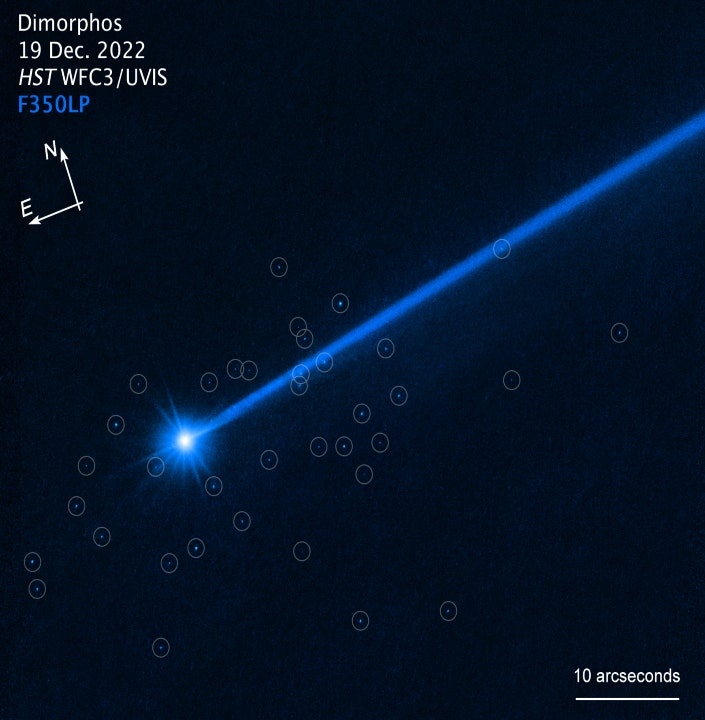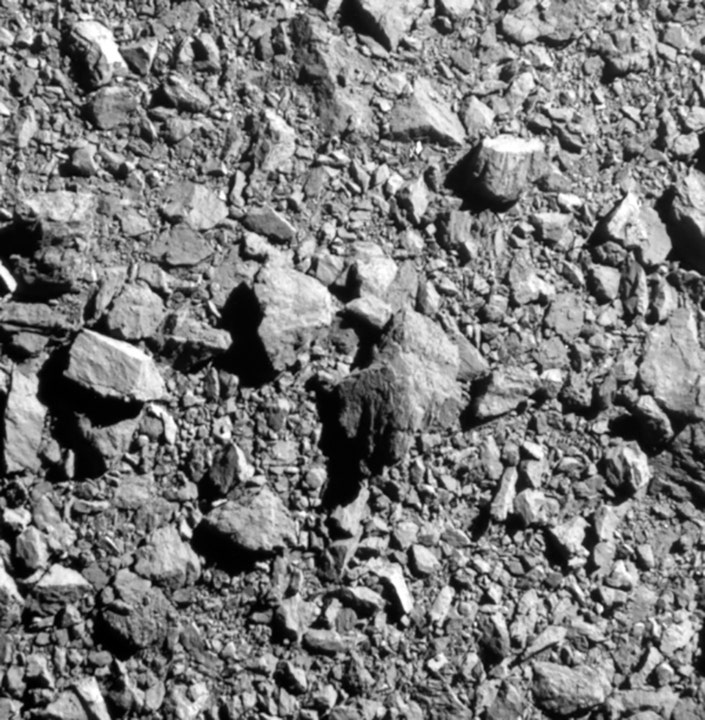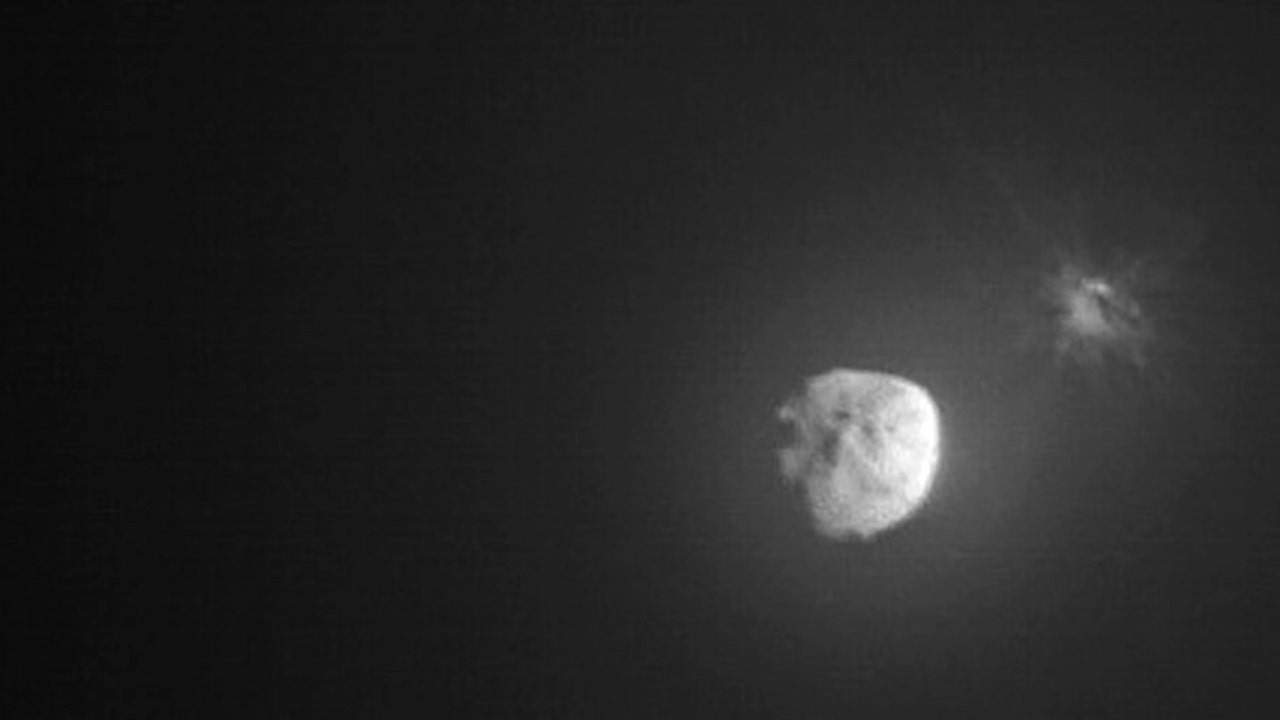The Hubble Space Telescope has found a swarm of boulders that were potentially shaken off the asteroid Dimorphos following NASA's Double Asteroid Redirection Test experiment last September.
The 37 boulders range in size from three feet to 22 feet across, based on Hubble photometry.
NASA says the space rocks are drifting away from the asteroid at little more than a half-mile per hour.
The total mass in the detected boulders is about 0.1% the mass of Dimorphos.
PERSEID METEOR SHOWER 2023: WHAT SKYWATCHERS SHOULD KNOW

Image of the asteroid Dimorphos, with compass arrows, scale bar and color key for reference. The north and east compass arrows show the orientation of the image on the sky. Note that the relationship between north and east on the sky (as seen from below) is flipped relative to direction arrows on a map of the ground (as seen from above). (Credits: NASA, ESA, David Jewitt (UCLA); Alyssa Pagan (STScI))
"This is a spectacular observation – much better than I expected. We see a cloud of boulders carrying mass and energy away from the impact target. The numbers, sizes and shapes of the boulders are consistent with them having been knocked off the surface of Dimorphos by the impact," David Jewitt, a planetary scientist of the University of California at Los Angeles, said in a statement. "This tells us for the first time what happens when you hit an asteroid and see material coming out up to the largest sizes. The boulders are some of the faintest things ever imaged inside our solar system."
The boulders are most likely not pieces of the diminutive asteroid caused by the impact, and they were already littered across the asteroid's surface as evident in the last picture taken by the spacecraft before its collision.
Jewitt, who has been using Hubble to track changes in the asteroid following the DART impact, estimates that the impact shook off 2% of the boulders on the asteroid's surface.

This is the last complete image of the asteroid Dimorphos, as seen by NASA's DART (Double Asteroid Redirection Test) impactor spacecraft two seconds before impact. The Didymos Reconnaissance and Asteroid Camera for Optical navigation (DRACO) imager aboard captured a 100-foot-wide patch of the asteroid. The DART spacecraft streamed these images from its DRACO camera back to Earth in real time as it approached the asteroid. DART successfully impacted its target on September 26, 2022. (Credits: NASA, APL)
He said that the boulder observations by the observatory also give an estimate for the size of the DART impact crater, noting that the "boulders could have been excavated from a circle of about 160 feet across (the width of a football field) on the surface of Dimorphos."
AUGUST FEATURES 2 SUPERMOONS, INCLUDING A BLUE MOON: WHAT TO KNOW
The agency says that Dimorphos may have formed from material shed into space by the larger asteroid Didymos.
It's not clear how the boulders were lifted off the asteroid's surface, although they could be part of an ejecta plume that was photographed by Hubble. A seismic wave from the impact also may have shaken the surface rubble loose.
"If we follow the boulders in future Hubble observations, then we may have enough data to pin down the boulders' precise trajectories. And then we’ll see in which directions they were launched from the surface," said Jewitt.

In this image made available by NASA, debris ejects from the asteroid Dimorphos, right, a few minutes after the intentional collision of NASA’s Double Asteroid Redirection Test (DART) mission on Sept. 26, 2022, captured by the nearby Italian Space Agency’s LICIACube. On Tuesday, Oct. 5, 2021, NASA said the spacecraft had succeeded in shifting its orbit. ((ASI/NASA via AP))
He said that this opens up a new dimension for studying the aftermath of the experiment using the European Space Agency's upcoming Hera spacecraft.
Hera, which is expected to arrive at the binary asteroid in late 2026, will perform a detailed post-impact survey of the targeted asteroid and eventually determine the size of the crater made by the spacecraft.
CLICK HERE TO GET THE FOX NEWS APP
"The boulder cloud will still be dispersing when Hera arrives," Jewitt explained. "It's like a very slowly expanding swarm of bees that eventually will spread along the binary pair's orbit around the Sun."
DART intentionally impacted Dimorphos on September 26, 2022, slightly changing the trajectory of its orbit around the larger asteroid Didymos.
Science - Latest - Google News
July 23, 2023 at 01:04AM
https://ift.tt/T91VcKm
Hubble Space Telescope finds boulders potentially shaken off asteroid following DART experiment - Fox News
Science - Latest - Google News
https://ift.tt/Il5z7oZ
https://ift.tt/ibmaky6
Bagikan Berita Ini

















0 Response to "Hubble Space Telescope finds boulders potentially shaken off asteroid following DART experiment - Fox News"
Post a Comment